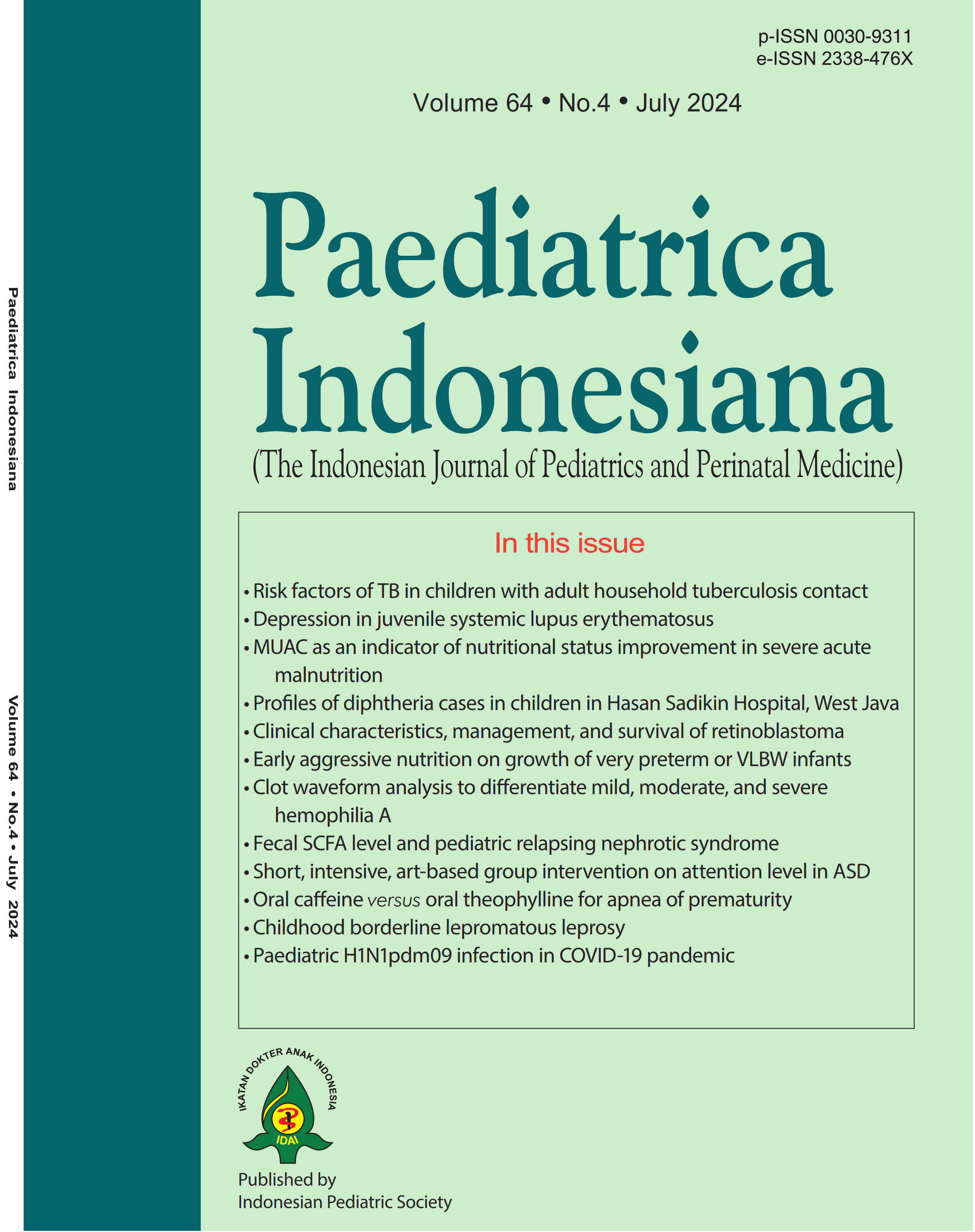Comparison of oral caffeine and oral theophylline for apnea of prematurity: A randomized clinical trial
Abstract
Background Caffeine and theophylline are methylxanthine compounds that have been widely used in the treatment of apnea of prematurity (AOP). Previous studies comparing the two agents have shown inconsistent results and have mostly used intravenous preparations.
Objective To assess the effectiveness of oral administration of caffeine compared to oral theophylline as therapy for apnea of prematurity.
Methods Fifty consecutively recruited premature neonates (gestational age 28-34 weeks, birth weight <2,500 g) with AOP who were able to tolerate at least 10 mL/kg of enteral feeding were randomized to receive either oral caffeine or oral theophylline for seven days. The main outcome was the daily frequency of apnea after treatment. Secondary outcomes were duration of oxygen or CPAP administration, duration of oxygen fraction (FiO2) taper to reach 21%, time to achievement of full feeding tolerance, length of hospital stay, and side effects.
Results We randomized 25 subjects into each group. The distribution of baseline characteristics (gender, gestational age, mode of delivery, birth weight and length, age at onset of AOP, and initial frequency of AOP) was similar between both groups. The mean daily number of apnea episodes after treatment was significantly higher in the caffeine group compared to the theophylline group [3.16 (SD 1.31) vs. 2.28 (SD 1.40); P=0.031]. The caffeine group, compared to the theophylline group, also had a longer mean duration of oxygen or CPAP use [12.56 (SD 7.67) days vs. 8.40 (SD 6.41) days; P=0.030] and duration of FiO2 taper [5.76 (SD 2.68) vs. 4.08 (SD 2.54); P=0.035]. There were no significant differences in mean time to full feeding and mean length of hospital stay. There was no significant difference in the occurrence of side effects between the two groups.
Conclusion In premature neonates with AOP, oral theophylline is slightly more effective than oral caffeine in reducing the frequency of apnea and is associated with a shorter duration of oxygen or CPAP use and duration to reach 21% FiO2.
References
2. Di Fiore JM, Poets CF, Gauda E, Martin RJ, MacFarlane P. Cardiorespiratory events in preterm infants: interventions and consequences. J Perinatol. 2016;36:251-8. DOI: https://doi.org/10.1038/jp.2015.165
3. Henderson-Smart DJ, Steer P. Methylxanthine treatment for apnea in preterm infants. The Cochrane Database Syst Rev. 2001;(3):CD000140. DOI: https://doi.org/ 10.1002/14651858.CD000140.pub2
4. Atik A, Harding R, De Matteo R, Kondos-Devcic D, Cheong J, Doyle LW, et al. Caffeine for apnea of prematurity: effects on the developing brain. Neurotoxicology. 2017;58:94-102. DOI: https://doi.org/10.1016/j.neuro.2016.11.012
5. Dobson NR, Hunt CE. Pharmacology review: caffeine use in neonates: Indications, pharmacokinetics, clinical effects, outcomes. NeoReviews. 2013;14:e540-50. DOI: https://doi.org/10.1542/neo.14-11-e540
6. Al Ansari E, Qeretli R, Fayed M, Altammami H, Akhras L, Alalaiyan S, et al. Caffeine therapy practice in the management of apnea of prematurity: National survey in Saudi Arabia. Journal of Clinical Neonatology. 2018;7:217-23. DOI: https://doi.org/10.4103/jcn.JCN_45_18
7. Skouroliakou M, Bacopoulou F, Markantonis SL. Caffeine versus theophylline for apnea of prematurity: A randomised controlled trial. Journal of Paediatrics and Child Health. 2009; 45: 587–92. DOI: https://doi.org/10.1111/j.1440-1754.2009.01570.x
8. Hendy H, Wandita S, Kardana M. Efficacy of aminophylline vs. caffeine for preventing apnea of prematurity. Paediatrica Indonesiana. 2014;:365-71. DOI: https://doi.org/10.14238/pi54.6.2014.365-71
9. Shivakumar M, Jayashree P, Najih M, Lewis S, Bhat R, Kamath A et al. Comparative Efficacy and Safety of Caffeine and Aminophylline for Apnea of Prematurity in Preterm (?34 weeks) Neonates: A Randomized Controlled Trial. Indian pediatrics. 2017; 54:279-83. DOI: https://doi.org/10.1007/s13312-017-1088-0
10. Zulqarnain A, Hussain M, Suleri KM, Ali Ch. Z. Comparison of Caffeine versus Theophylline for apnea of prematurity. Pak J Med Sci. 2019;35:113-16. DOI: https://doi.org/10.12669/pjms.35.1.94.
11. Habibi M, Mahyar A, Nikdehghan S. Effect of Caffeine and Aminophylline on Apnea of Prematurity. Iranian Journal of Neonatology. 2019; 10:37-41. DOI: https://doi.org/10.22038/ijn.2019.330 41.1468.
12. Vliegenthart R, Miedema M, Miedema GJ, Kaam AH, Onland W. High versus standard dose caffeine for apnoea: a systematic review. Archives of Disease in Childhood - Fetal and Neonatal Edition.2018;103:F523-F529. DOI: https://doi.org/10.1136/archdischild-2017-313556.
13. Jeong K, Kim HS, Song ES, Choi YY. Comparison between caffeine and theophylline therapy for apnea of prematurity. Neonatal Med. 2015;22:14-20. DOI: https://doi.org/10.5385/nm.2015.22.1.14
14. Zhang CY, Liu DJ, Hua SD, Guo S, Li XY, Zhang B, et al. Caffeine versus aminophylline in combination with oxygen therapy for apnea of prematurity: a retrospective cohort study. Exp Ther Med. 2020;20:46. DOI: https://doi.org/10.3892/etm.2020.9175
15. Han S, Mallampalli RK. The Role of Surfactant in Lung Disease and Host Defense against Pulmonary Infections. Annals of the American Thoracic Society. 2015;12:765-74. DOI: https://doi.org/10.1513/AnnalsATS.201411-507FR
16. Fanaro S. Feeding intolerance in the preterm infant. Early Human Development. 2013;89:S13-20. DOI: https://doi.org/10.1016/j.earlhumdev.2013.07.013
17. Albraik RK, Shatla E, Abdulla YM, Ahmed EH. Neonatal Feeding Intolerance and Its Characteristics: A Descriptive Study. Cureus. 2022;14:e29291. DOI: https://doi.org/10.7759/cureus.29291
18. Niknajad A, Ghojazadeh M, Sattarzadeh N, Hashemi FB, Shahgloli FD. Factors affecting the neonatal intensive care unit stay duration in very low birth weight premature infants. J Caring Sci. 2012;1:85-92. DOI: https://doi.org/10.5681/jcs.2012.013
Copyright (c) 2024 Nensy - Anggrainy, Gatot Irawan Sarosa, Adhie Nur Radityo Suswihardhyono

This work is licensed under a Creative Commons Attribution-NonCommercial-ShareAlike 4.0 International License.
Authors who publish with this journal agree to the following terms:
Authors retain copyright and grant the journal right of first publication with the work simultaneously licensed under a Creative Commons Attribution License that allows others to share the work with an acknowledgement of the work's authorship and initial publication in this journal.
Authors are able to enter into separate, additional contractual arrangements for the non-exclusive distribution of the journal's published version of the work (e.g., post it to an institutional repository or publish it in a book), with an acknowledgement of its initial publication in this journal.
Accepted 2024-09-02
Published 2024-09-02













